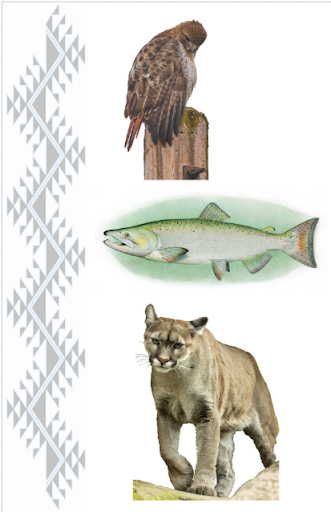Overview
Appreciation of Animals in the Elements of Water, Air, and Land

Contributors:
Author: Cheryl Tuttle (Yurok/Karuk) Educator and Cultural Preservationist
Lesson Contributor/Editor/Format by Maggie Peters (Yurok/Karuk) NASMC Learning Specialists Humboldt County Office of Education
Grade: 2
Suggested Amount of Time: Three 60 minute sessions or six 30 minute sessions
Curriculum Themes:
- Relationship to Place
- Cross Curricular Integration
Learning Goals
- Students will learn the type of environments salmon need to thrive and survive.
- Students will be able to discuss our role, as caretakers of the land, to nurture and protect our environment.
- Identify characteristics of a red-tailed hawk.
- Describe the features of a mountain lion that makes it an effective predator.
Lesson Overview
This three-part unit introduces students to the salmon, red-tailed hawk, and mountain lion as key species representing the water, air, and land ecosystems of California. Across each 60-minute session, students explore how these animals live, survive, and contribute to their environments, to understand why Native peoples in California hold a deep respect for them.
In Session 1, students study the salmon’s life cycle, including its migration between freshwater and saltwater, the importance of clean, shaded rivers, and the impact of pollution and drought on its survival. Through discussion, partner work, and short writing prompts, students build a foundational understanding of the salmon’s environmental needs and cultural significance.
Session 2 shifts focus to the red-tailed hawk, emphasizing its role as a top predator and its adaptations for hunting, nesting, and raising young. Students learn how hawks contribute to balanced ecosystems by controlling rodent populations, supporting both natural systems and human agriculture.
In Session 3, students explore the mountain lion’s powerful body and sharp senses, its hunting techniques, and its role in maintaining healthy deer populations. They discuss how mountain lions use terrain to stalk prey and how they support biodiversity through their interactions with other animals.
Each session ends with students compiling their learning into a personalized booklet, reinforcing content through writing, drawing, and storytelling—encouraging students to reflect on their relationship with the natural world and their responsibilities as environmental stewards.
Teacher Background
For the many California Native peoples the salmon, red-tailed hawk and mountain lion are esteemed animals.
For the Yurok, the health of the salmon reflects the health of the Yurok people for the salmon are an essential food source and many cultural traditions are based on salmon. Fishing, cooking, drying, smoking, canning, making nets, making sticks for cooking, prayers and songs all come from salmon being an integral part of Yurok life. Many other tribes in California have similar beliefs and ceremonies honoring salmon and other animals in our environment.
The red-tailed hawk is seen as a good hunter. When one is able to find a red-tailed hawk and use its feathers, that is seen as lucky and a blessing. Being able to use the hawk’s feathers allows this esteemed animal to live on in ceremony for years to come. Its beautiful feathers are used in regalia, including feather capes and feather bunches.
The mountain lion is well respected up and down California. With its large size, incredible senses and astute hunting ability, the mountain lion has made its way into many California Native peoples stories that tell of creation and teach lessons. The mountain lion is not only respected, but also feared, as it reminds us that we need to stay alert and within our own boundaries to stay safe.
Learning about these animals and their interaction with their environment gives students foundational knowledge important in understanding not only their environment, but also Native California culture.

